Jock McFadyen: ‘Painting is artifice, it’s art, and so is the made environment’
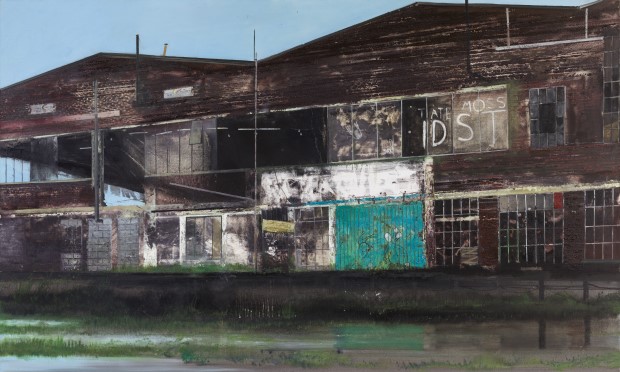
It’s always the right of a given year’s ‘Coordinator’ to hang Gallery III at the Royal Academy’s Summer Exhibition.
This year that honour – and honour’s the word, skylight-lit, sports-hall size expanse of white wall and gilded moulding that Gallery III is – falls to east London painter Jock McFadyen.
“It’s hard work,” McFadyen says, frankly, of the job. “There were 16,250 entries. We invited about three thousand people “to bring their work in, and we hung about half of it. Just under 1,600 works. It’s massive, so it’s quite a lot of work, it has to be hung in nine days flat.”
The Summer Exhibition – held at the Royal Academy in central London, just off Piccadilly – is fun because anyone can enter a painting, and a great many of them are shown.
Everything’s also up for sale, with prices marked in a little book you get on the way in.
This seems to make people much more relaxed and chattier than at other shows: if you might buy it, you’re entitled to have an opinion, and it’s possible any work you dislike isn’t even by someone who’s meant to be good.
And the sheer number of works means you have to form judgements, follow your interests. You can’t see it all.
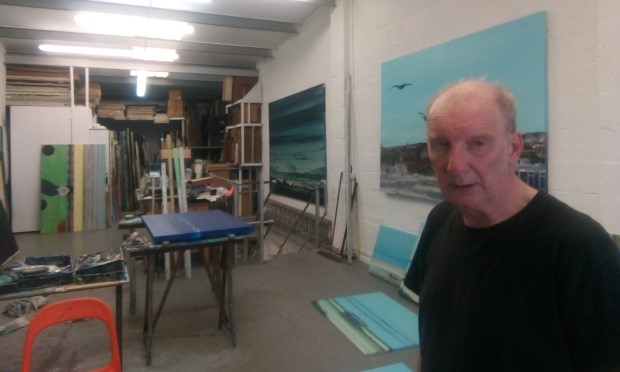
Around chest height a little way into Gallery VII is a striking print by McFadyen, a sky that makes you wince at nature’s ability to fade deep orange, somehow, into palest blue.
In the foreground is a derelict cafe-bar, alone on the road for miles, looking like it was abandoned halfway through something, things still up on the walls, pealing from them. Not somewhere you’d want to be, but somewhere it looks like some people did once like being, before they were gone.
Looking perhaps an American scene, it is, in fact, according to the title, Somewhere in Normandy.
McFadyen has assembled “a strong armature, or template, or spine”, as he puts it, of invited submissions for the summer show, including Hackney artists Tom Hunter, John Davies, Cathy de Monchaux, Hugh Mendes, Hannah Collins and Liz McGill.
Rattling off a long list of painters, printers and photographers with studios nearby, he finishes: “There’s loads of artists round here. These studios here are full of the bastards, hundreds of them.”
But he’s also alive to a changing scene.
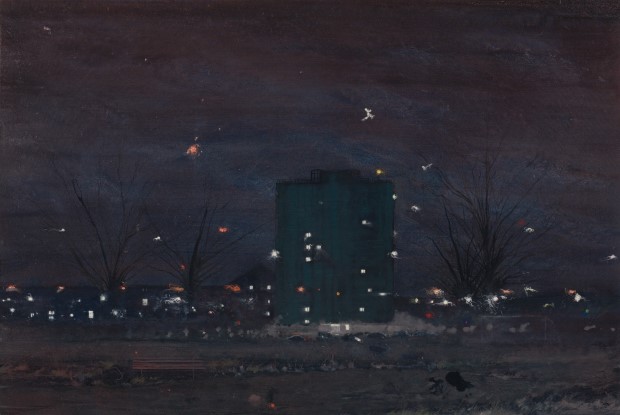
On his window is a poster for Guardians of the Arches, a campaign formed from railway arch businesses against rent increases from their landlords, Transport for London and Network Rail.
He’s had a studio near London Fields for nearly 20 years, and before that been in Brick Lane and in Bow. Born in Paisley, near Glasgow, in 1950, he moved to London aged 15 and studied at Chelsea Art School in the 1970’s.
Many of his works are of urban landscapes, recognisable places such as Walthamstow dogtrack, Roman Road, London Fields.
“I’m interested in the tension between made things and nature,” he says of this subject matter. “What’s there outside – and that has to include buildings because they permeate.”
He gives a wonderfully straightforward account of his artistic process: “I usually paint on canvas with oil paint,” he states. “I like to have a subject.”
In McFadyen’s paintings of east London there’s a peacefulness, the kind of peace there used to be in Hackney Wick and which you still find at the further reaches of the River Lea.
Things let be, allowed to be themselves, even, or especially, in repose, dilapidation, bad weather.
This is partly because of the paintings’ composition, the way for example in Tate Moss (2010) or London Fields (2007) a particular building anchors the painting, gives it a clear area of focus.
In London Fields that’s a housing block, picked out in dark green against maroon clouds on a windy night.
In Tate Moss it’s an old industrial building demolished to make way for the Olympic Park, discovered on a visit with Iain Sinclair into the sealed construction site via inflatable canoe.
“We went in while they were demolishing it,” recalls McFadyen “All the hard hats, all the digging machines, cranes and everything – and I saw this building, which had obviously been squatted by young artists, they’d obviously been having art events of some kind and I thought it was great. So I made a big painting of it.”
The paint in the paintings is allowed to be itself, too.
The concern for the accurate visual representation of the thing painted is balanced by a way of laying the paint down such that its own textures and interest are apparent, too, a plainness about how the paint is ‘what’s there’ as much as anything else.
In Tate Moss, for example, paint is thinly spread out where the building’s glass windows are, piled up and knobbly on the brickwork.
In this painting, “the counterpoint between staining and impasto is what interests me”, McFadyen says, “because I was taught by abstract painters, not realist painters, so all my sensibility is about the paint, rather than trying to make the paint contort itself into an illusion.”
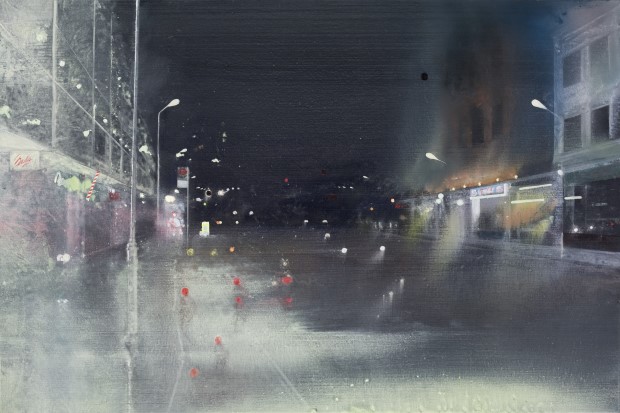
The effects that can be achieved make the large expanses in McFadyen’s paintings fascinating, especially potentially unpromising, grey, expanses like the pavement and tarmac sheened with rain that takes up the bottom half of Roman Road (2007), the paint worked intricately to demonstrate the range and variety of colour light takes on when reflected off such a surface, and the range and variety of colour paint can take on to show you so.
Almost the whole of Last Days of the Age of Reason (2012) is white or grey, but you can wonder at it for hours about how the whitewashed speedbowl barrier wall in the foreground is its own self, distinct from the white clouded dull sky behind it.
McFadyen describes his as a style in which paint behaves like the thing it shows, forms “an analogous relationship with the perceived world”.
This in contrast to, say, Canaletto, whom McFadyen greatly admires yet whose approach to, for instance, painting clouds is, you might characterise, “saying ‘a cloud looks like this, I’m going to draw it and fill it in, and put shadows’”.
To do something different, says McFadyen, “you can have realism which is an analogous realism, a metaphorical realism, so you can make the sky by pouring [paint onto the canvas] – or you can do water by pouring, so the person looking at it perceives wetness because they know it’s wet paint that’s been poured onto a painting – watery paint’s the analogue for water.”
He’s delighted by how the impasto bricks in Tate Moss have caught dust, “because that’s what would happen in a real building. Painting buildings, streets, also puts you in touch with other artists, as with the shopfronts in Roman Road“.
“It’s funny with painting things like that because painting is artifice, it’s art, and so is the made environment,” McFadyen says. “Who told them to paint that blue, the garage?”
He gestures out of his studio’s window. “If you’ve got a line of shops, someone’s designed the signage, somebody’s designed the shape of the windows, so somebody’s an artist – I mean there’s a confluence of different aesthetic decisions, isn’t there?”
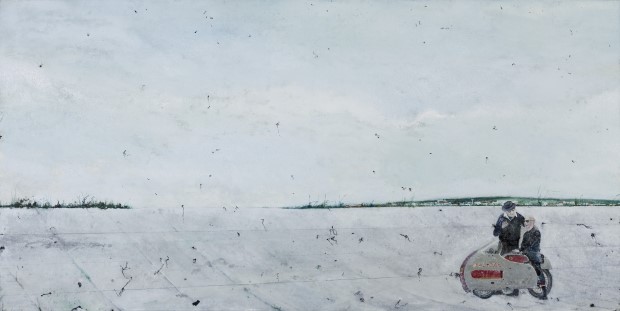
There is also such a confluence in an individual painting, and the sense that the streams could have run slightly differently occasions McFadyen’s practice of producing several versions of the same work.
“I sometimes paint the same painting again. You probably think I’m like Henry Ford,” he says, gesturing at several canvases in different stages of completion, each showing the same scene, a little like a line of Model T’s being fitted up.
“I quite enjoy painting the same painting again. When you’ve painted it once you’re sort of in the throes of invention, you’re thinking ’oh right, so I’ll try this, I’ll try that’, but once you’ve painted it, you think, ‘oh, what a waste, now I’ve got this I’ll do another one, I’ll try it slightly differently.”
The work takes up a place in the heart, like a good tune.
“If you’re a musician you would do that, play your hits every night for years. Most people just want to hear the old hits, you know.”
There’s a new book out about McFadyen, written by the Observer’s architecture critic Rowan Moore and published by the Royal Academy.
He’ll have his own show there in 2021, with other solo shows coming up next year.
